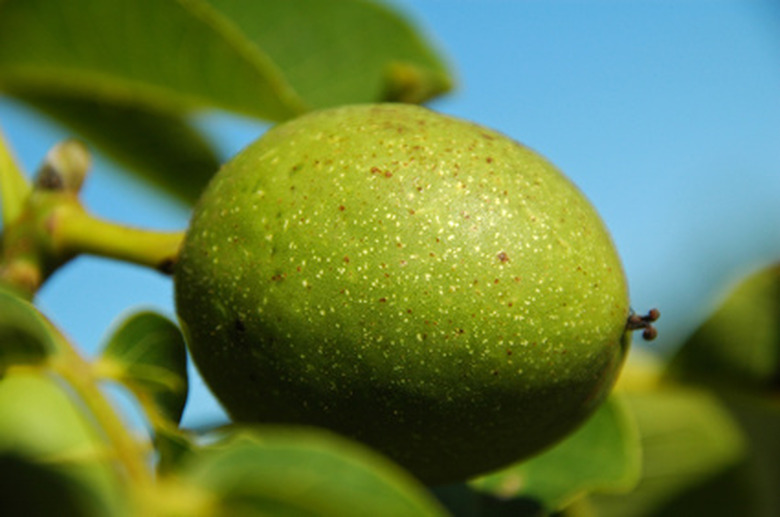Black Walnut Trees And Soil Toxicity
Black walnut trees are one of the United States' largest and most valuable native trees, able to grow to massive size under even difficult growing conditions. However, the tree is known as a species that doesn't "play nice" with other popular garden plants, including several types of vegetables and ornamental shrubs. Careful husbandry of the tree, however, can help reduce levels of the responsible toxin in the soil.
About Black Walnut Trees
The black walnut (Juglans nigra) is a slow-growing hardwood tree native to Virginia. The trees are found as far north as Maine, westward to Michigan and south into Georgia and Texas. Black walnut is the tallest and largest of all the walnut species, frequently growing to 100 feet or more; the tallest and narrowest specimens are particularly valued for their use in walnut veneers and other ornamental wood products. Black walnut is valued in the landscape for its drought tolerance, shade qualities and disease resistance.
- Black walnut trees are one of the United States' largest and most valuable native trees, able to grow to massive size under even difficult growing conditions.
- Black walnut is the tallest and largest of all the walnut species, frequently growing to 100 feet or more; the tallest and narrowest specimens are particularly valued for their use in walnut veneers and other ornamental wood products.
Toxic Compounds
Black walnut is one of several types of trees to produce a chemical known as hydrojuglone, a colorless, nontoxic chemical. This compound is found in all parts of the black walnut tree, including leaves, stems, nut hulls, bark and roots. When hydrojuglone is exposed to air, it becomes a problem, as it oxidizes and becomes juglone, a highly toxic compound. Root contact between plants, rain dripping from leaves, waterlogged soils and decaying leaves are the main methods juglone comes into contact with other plants. Because a black walnut tree's roots may extend up to 80 feet from its canopy, even plants situated at a distance from the tree can be affected.
Juglone and Soil Toxicity
Though juglone tends not to leach into soils far from its source, several factors can lead to higher accumulations of juglone around black walnuts. Microbial action, which naturally reduces concentrations of juglone in soils, may be inhibited by the presence of too much water, so poorly drained, compacted or frequently cold soils tend to have higher concentrations of juglone. Allowing fallen leaves to accumulate beneath a walnut tree can also increase soil toxicity, since they hold water and reduce the amount of oxygen reaching the soil. Keeping the area beneath black walnut trees aerated and clear of fallen tree debris can contribute to lower levels of juglone in the surrounding soil.
- Black walnut is one of several types of trees to produce a chemical known as hydrojuglone, a colorless, nontoxic chemical.
- Allowing fallen leaves to accumulate beneath a walnut tree can also increase soil toxicity, since they hold water and reduce the amount of oxygen reaching the soil.
Effects on Plants
Juglone is thought to contribute to a plant's decline and eventual death by inhibiting metabolic pathways related to respiration. The first outward symptoms of juglone poisoning in a plant is yellowing and wilting of foliage, followed in time by death. While many types of native vines, shrubs and trees are tolerant of juglone, several popular vegetable and ornamental plants succumb quickly to the effects of juglone. Apples, azaleas, blackberries, blueberries, grapes, peonies and pine will not grow in close proximity to black walnut, nor will tomatoes, potatoes, thyme, rhododendron, lily-of-the-valley, chrysanthemum or crocus.
Plants to Grow Beneath Black Walnut
Even without active husbandry, many native and ornamental plants tolerate the presence of juglone in soils. Japanese maple, Eastern redbud and dogwood are two ornamental shrubs that grow well beneath black walnut; vines, including clematis, honeysuckle and Virginia creeper are also suitable. Hydrangea, flowering lilac, paw-paw, sassafras, serviceberry and witch hazel are other types of trees that grow beneath black walnut; perennials suitable for placement in proximity to the tree include Siberian iris, fern, hardy geranium, daffodils, astilbe, phlox and trillium.
- Juglone is thought to contribute to a plant's decline and eventual death by inhibiting metabolic pathways related to respiration.
- Japanese maple, Eastern redbud and dogwood are two ornamental shrubs that grow well beneath black walnut; vines, including clematis, honeysuckle and Virginia creeper are also suitable.
